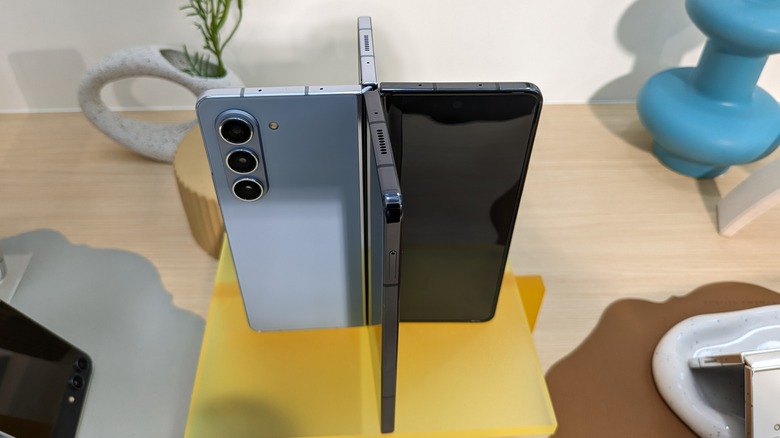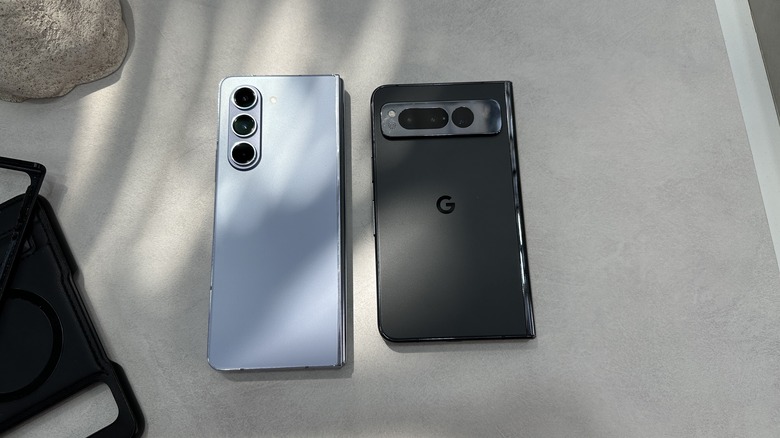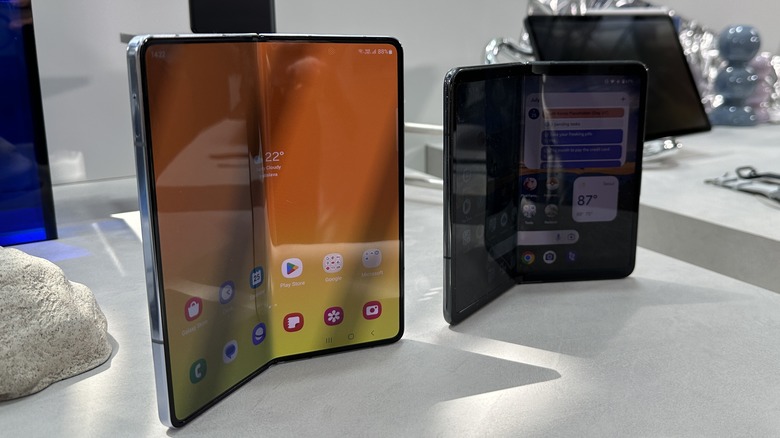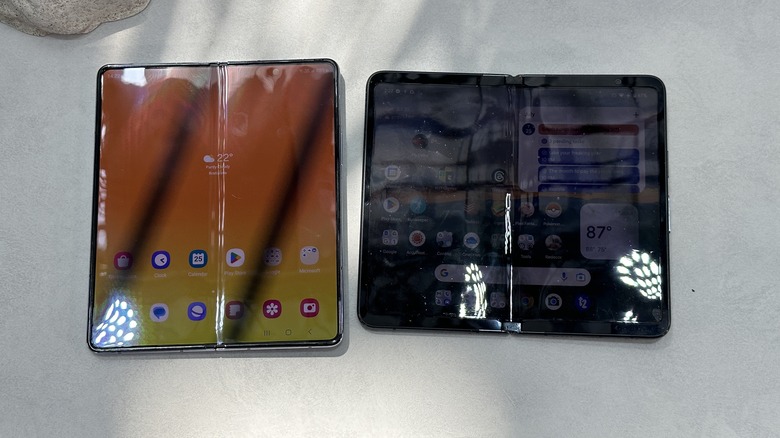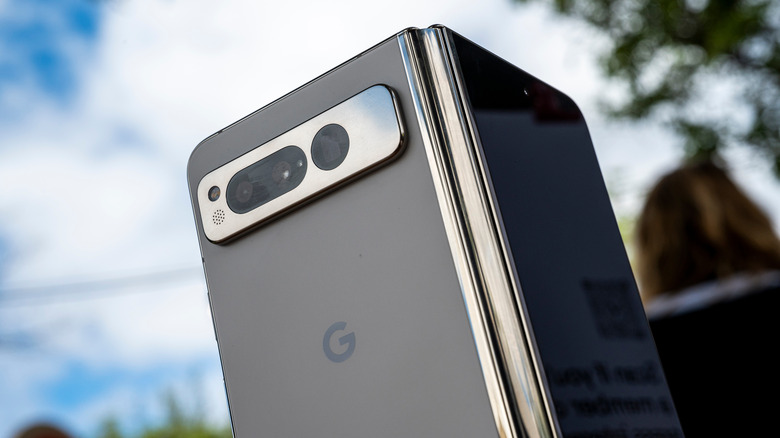Galaxy Z Fold 5 Vs. Google Pixel Fold: Which Is The Best Foldable Android Phone?
Samsung has been the dominant player in the foldable smartphone market since it introduced the Galaxy Fold in 2019. The company's early lead was partly due to its strong brand reputation and ability to secure carrier partnerships in key markets. However, Samsung's dominance was also helped by the fact that most of its competitors were Chinese brands with limited U.S. availability. This made it difficult for these brands to build brand awareness and trust with American consumers.
Things changed in 2023 when Google entered the foldable smartphone market with the Pixel Fold. This new device was a significant product launch for Google, as it was the first foldable phone from Google — a brand with excellent name recognition among American consumers. And despite some of its shortcomings, the Pixel Fold was well-received by critics, who praised its excellent display, powerful performance, and long battery life.
Now that Samsung has announced the Galaxy Z Fold 5 — the company's flagship foldable offering for 2023 — it is perhaps a good time to do a comparative analysis of these two devices that may share the same form factor but could not be more different in most other aspects.
Galaxy Z Fold 5 vs. Google Pixel Fold: Which has the better hardware?
While Samsung made the obvious decision to use the latest flagship-grade chip from Qualcomm for the Fold 5, the Google Pixel Fold comes powered by Google's own Tensor G2 chip, which is also used on the company's almost-year-old Pixel 7 devices. Despite some improvements over the first gen Tensor G1 chip, the G2 is not particularly known for its performance. Yes, it can handle most tasks you throw at it, but it is significantly behind the Fold 5's Snapdragon 8 Gen 2 chip in terms of CPU and GPU power.
While both the handsets feature 12GB of RAM, Samsung offers you the option to buy a 1TB variant of the Galaxy Z Fold 5. In comparison, the Pixel Fold tops out at 512GB. The Fold 5 also supports UFS 4.0 storage, as opposed to the older UFS 3.1 standard that the Pixel Fold uses. This feature alone should translate to a significant speed advantage in favor of the Fold 5.
The Pixel Fold has the larger battery of the two devices, boasting a typical capacity of 4821 mAh compared to the Flip 5's 4400 mAh battery pack. Real-life battery life performance, however, won't be known until the Fold 5 has been fully tested. Google also wins the charging speed battle, thanks to 30W wired fast charging support instead of 25W fast charging support on the Galaxy Z Fold 5. Both the handsets support wireless charging.
Galaxy Z Fold 5 vs. Google Pixel Fold: How do their displays compare?
While these foldable devices share an identical form factor, consisting of an external cover display and an inward folding foldable main panel, Google has opted for a wider footprint than the Fold 5's taller design. This difference is reflected in the display resolution and the aspect ratio figures for the main display.
On paper, the internal folding display on both devices measures 7.6 inches across. However, the Pixel Fold's panel boasts a resolution of 2208 x 1840 pixels in the 6:5 aspect ratio compared to the 2176 x 1812 pixel, 21.6:18 display of the Galaxy Z Fold 5. Both these displays support a 120Hz refresh rate, but the Fold 5's internal display is the brighter of the two (1750 nits peak) compared to the Pixel Fold's panel, which claims a peak brightness of 1450 nits.
Moving on to the cover display on these devices, the Galaxy Z Fold 5 is the larger and taller of the two, measuring 6.2 inches across with a resolution of 2316 x 904 pixels in the 23.1:9 aspect ratio. The Pixel Fold's cover display measures 5.8 inches across and uses a wider 17.4:9 aspect ratio while boasting a resolution of 2092 x 1080 pixels. Both these panels support a 120Hz refresh rate.
Galaxy Z Fold 5 vs. Google Pixel Fold: Can Samsung's camera match up?
Google's Pixel smartphones have an enviable reputation for their cameras. Now that the company has a Pixel-branded foldable device in the market, it will be interesting to see how Samsung's flagship foldable phone fares against the Pixel Fold. Given that we have yet to test the Galaxy Z Fold 5 extensively, we'll limit the comparison to hardware specs.
Both these foldable smartphones feature a triple camera array at the rear. While Samsung has opted for a 50MP primary camera (OIS), a 12 MP ultra-wide camera, and a 10MP telephoto camera (OIS), the primary camera on the Pixel Fold uses a 48MP sensor (with OIS). In addition to this, the phone also gets twin 10.8MP sensors for the ultrawide and telephoto cameras. Unfortunately, the Pixel Fold misses OIS support or the telephoto camera. The folding form factor of these devices leaves space for two front-facing cameras.
In the case of the Galaxy Z Fold 5, the camera flanking the external cover display uses a 10MP sensor. At the same time, the internal camera — which also happens to be an under-display camera — has a resolution of 4MP. The Google Pixel Fold's external cover display camera uses a 9.5MP sensor, while the inner camera gets an 8MP sensor.
Galaxy Z Fold 5 vs. Google Pixel Fold: Pricing and availability
The Samsung Galaxy Z Fold 5 is not only the newer of the two devices, but will also be available for purchase in several more countries than the Pixel Fold. For those unaware, the Google Pixel Fold is officially on sale in just four countries: Germany, Japan, the United Kingdom, and the United States.
In the U.S., pricing for the Samsung Galaxy Z Fold 5 starts at $1,799.99 for the 256GB variant, going up to $1919.99 for the 512GB variant and $2009.99 for the 1TB variant. In the case of the Google Pixel Fold, the base 256GB variant is on sale for $1799, while the more expensive 512GB variant will set users back by $1919. This effectively means that both these devices are identically priced.
If you are in the market for a foldable phone, there is no denying that you may consider either of these devices. Given that Samsung has extensive experience designing and manufacturing foldable phones, we think the Galaxy Z Fold 5 does make for a safer bet. However, since we haven't extensively tested the device, it might be a good idea to wait for our detailed review before making a purchase commitment. The Google Pixel Fold is not a bad choice, but it does have several things going against it, including its slower hardware and buggy software issues.
